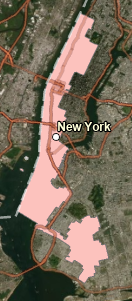Lab 5 [GIS5935]: Surface Interpolation
In this lab we examined various interpolation methods
to create a surface of water quality in Tampa Bay. Each method received as
input a set of sample points containing Biochemical Oxygen Demand (BOD) values
in milligrams per liter that were recorded from various points throughout the study
region.
The interpolation methods used this case study
included the following:
|
Thiessen |
IDW |
Spline - Regularized |
Spline -
Tension |
|
This interpolation method is a special case
of IDW where only the nearest water sample is used to estimate the BOD value
at an unsampled location. |
This interpolation method uses a preset
number of nearest neighbors to estimate the BOD value at an unsampled
location, and inversely weights the contributing strength of these neighbors
based on their distances from the unsampled location. |
Spline interpolation methods work to
fit a smooth surface exactly touching the BOD sampled points, while also minimizing
overall surface curvature between these points. |
|
|
A regularized spline can produce values
outside the sampled BOD data range. |
A tension spline controls the surface
generation to more closely align to the sampled BOD data range. |
||
The screenshot below shows the results of interpolation using the Spline – Tension technique with 9 classes:
Values
in red represent low BOD values and values in green represent high BOD values. This
surface is more visually appealing due to its smooth transitions compared to
the Thiessen method, where abrupt changes were observed at polygon boundaries. In
addition, although the IDW-generated surface produced a smoother visualization (Bolstad,
2016, pp. 530) compared to the Thiessen method, the IDW result was not as successful
at predicting valleys and peaks in the final visualization compared to the
spline methods. Overall, the Tension-based spline technique performed best in
terms of a smoothly created surface without significant amounts of underestimating
or overestimating throughout the study region.



Comments
Post a Comment